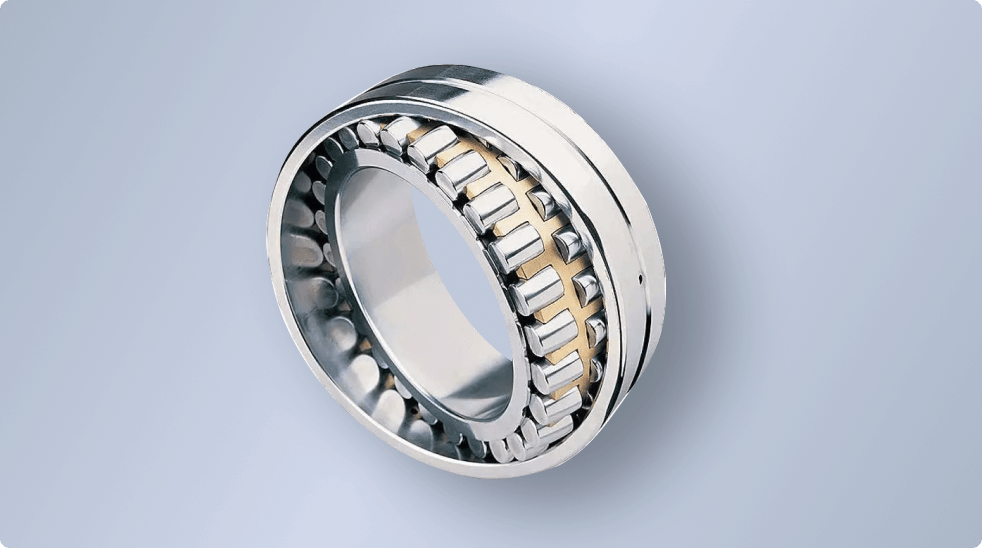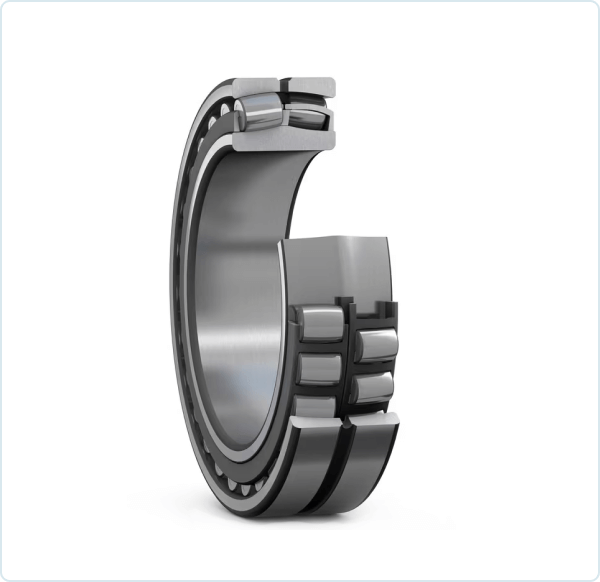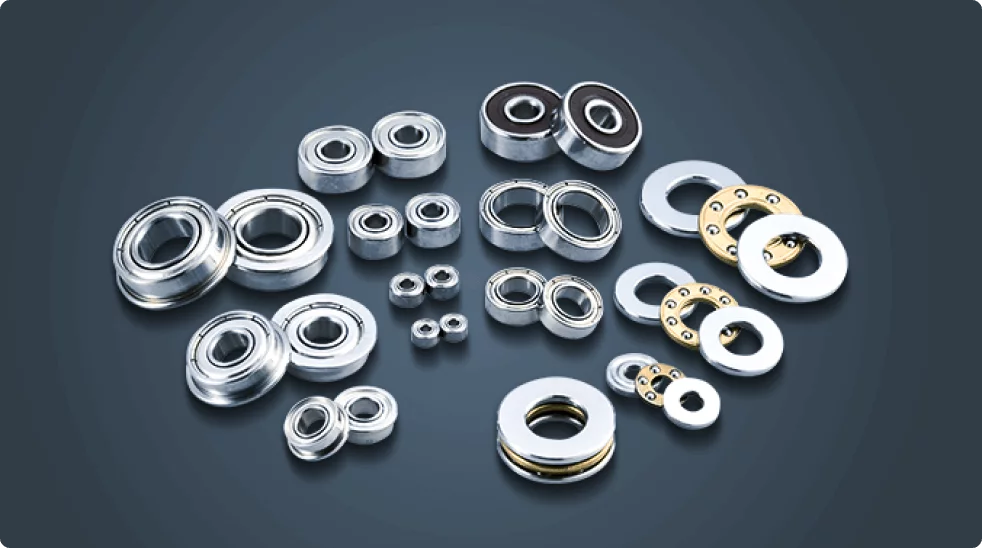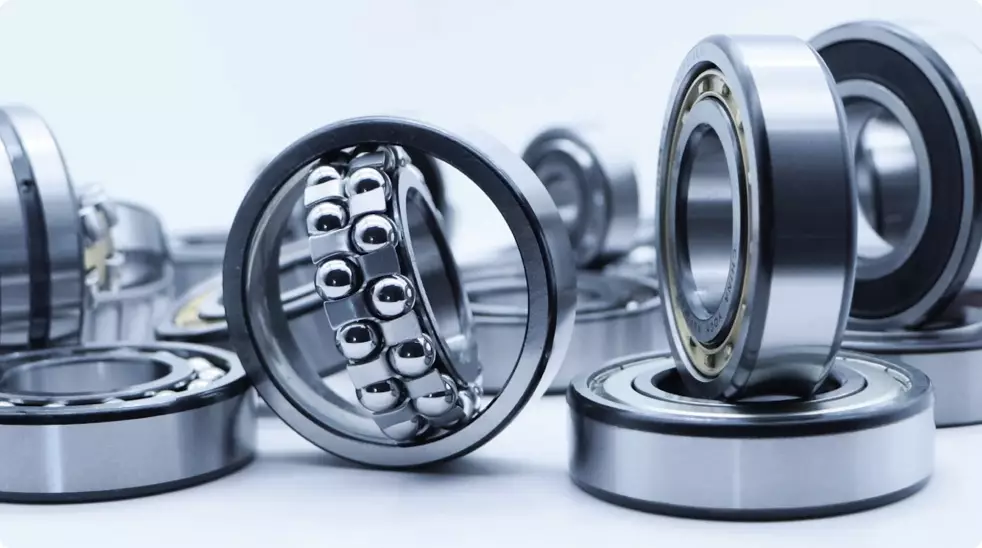
Spherical Roller Bearings: uses, dimensions, advantages
Spherical Roller Bearings
Spherical Roller Bearings are designed for carrying high loads. Of all rolling bearings spherical roller bearings are applied wherever high shock forces are present. In addition to shock loading this type of bearing is capable of handling various misalignments and shaft deflections.
What are spherical roller bearings used for?
Spherical roller bearings are a distinctive type of rolling-element bearing that are particularly designed to manage high radial loads while also accommodating misalignment, which can occur between the shaft and the housing. They are uniquely characterized by their barrel-shaped rollers, which are arranged between inner and outer rings. The spherical shape of the rollers allows for angular misalignment of the shaft relative to the housing. The applications and uses of spherical roller bearings are diverse and widespread due to their robustness and versatility:
High Radial Load Applications
- Heavy Machinery: These bearings are commonly used in sectors involving heavy machinery, such as mining, construction, and agriculture, due to their ability to withstand heavy radial loads and shocks.
- Gearboxes: In industrial gearboxes, spherical roller bearings support high radial and axial loads while also compensating for misalignments, which are common in these applications.
- Wind Turbines: They are used in wind turbines due to their capacity to support the heavy loads and handle the misalignment issues typically found in these applications.
Applications Requiring Accommodation of Misalignment
- Paper Mills: In papermaking machinery, misalignment often occurs due to the long shafts and the expansion and contraction of components. Spherical roller bearings are ideal in this environment.
- Marine Propulsion Systems: These bearings can handle the misalignment present in marine shafts and propulsion systems, providing reliability under varying loads and speeds.
- Conveying Systems: In belt conveyors and other material handling systems, these bearings can cope with misalignment while carrying heavy loads.
High-Speed Applications
- Industrial Fans and Blowers: Spherical roller bearings are suitable for high-speed applications, like in large industrial fans, where they can handle both radial and axial loads efficiently.
- Pumps and Compressors: In pumps and compressors, these bearings support high-speed shafts while accommodating misalignment and load fluctuations.
High Vibration and Impact Loads
- Vibrating Screens and Feeders: The ability of spherical roller bearings to accommodate misalignment and handle heavy, impact loads makes them ideal for vibrating screens and feeders.
- Railway Axleboxes: They are used in railway axle boxes, especially in applications where there are high radial loads and misalignment due to track irregularities.
Double Row Spherical Roller Bearings SKF

Spherical Roller Bearings are of a double row design, with two rows of rollers sharing a common spherical raceway in the outer ring. This feature enables this bearing to be completely self aligning. The wide series version of Spherical roller bearings has an integral flange which guides the roller and is utilized between the raceways of the inner ring. When in no load the rollers maintain line contact with the raceways of the inner ring and point contact at an extremely high degree of osculation with the raceway in the outer ring.
The rollers are barrel shaped with one end larger than the other. As a result of this design the rollers are pushed against the center guide flange with a force which while small is great enough to hold the larger end surface of the rollers in continuous contact with the flange ensuring proper guidance. With both the guiding surface of the flange and the end surfaces being spherical, full surface contact is maintained. The real purpose of the flanges is keeping the rollers in the bearing when the outer ring is removed.
Machine brass cages with open pockets are commonly used in this type of bearing. This type of cage design allows for lubricants to reach the rolling and sliding surfaces from both sides easily. As a rule, the outer ring likely has a peripheral groove with three radial holes in the outer ring which allows for feeding lubricant to the bearing efficiently.
Bearing rings and rolling elements are generally manufactured using AISI 52100 chromium steel. While brass cages are the most common for roller retention other materials used include Sheet steel, Polymide and machined steel.
All sizes and types of spherical roller bearings are made with tapered bores where they can be mounted using and adapter, a removable sleeve or directly mounted on a mating tapered shaft.
Narrow Spherical roller bearings
In the narrow type of spherical roller bearing no integral flanges are used in the design. The rolling guidance is accomplished by a separate guide inserted into the outer ring by elastic deformation. The narrow spherical roller bearing is very useful for high radial capacity applications. The reduced width and reduced angularity of the rollers causes this type of bearing to have a lesser axial capacity than the wide type. Sometimes the narrow version is substituted for a ball bearing where they would have insufficient load carrying capacity and where then narrow width could be used. This type of bearing can also be manufactured in small sizes.
The most common series are 213, 222, 223, 231, 232, 238 and 239.
Applications for Spherical roller bearings include vibrating screens, rolling mills, shakers, conveyors, transmissions, heavy support rollers, stone crushers, Wind turbines, all types of mining and construction equipment and material handling equipment.
What is used to measure clearance in spherical roller bearing?
1. Feeler Gauges
Feeler gauges are one of the most common tools used for measuring the clearance in spherical roller bearings. These are thin strips of metal with precise thicknesses, used to measure the gap between components. To measure clearance, a feeler gauge of known thickness is inserted between the roller and the raceway. The appropriate gauge is the one that fits snugly without excessive force.
2. Dial Indicators
Dial indicators are precision instruments used to measure small distances or angles. When used for bearing clearance, the indicator is positioned to measure the movement of the outer ring relative to the inner ring. This method can provide highly accurate measurements and is particularly useful for larger bearings.
3. Micrometers
Micrometers, especially those designed for specific bearing types, can be used to measure the dimensions of the bearing components directly. By measuring the outer ring, inner ring, and rollers, and then calculating the expected internal geometry, the clearance can be inferred.
4. Specialized Tools and Instruments
Some manufacturers and maintenance teams use specialized tools designed specifically for measuring bearing clearance. These tools can range from simple mechanical devices to advanced electronic systems that provide digital readings.
5. Ultrasonic Thickness Gauges
In some cases, ultrasonic thickness gauges are employed. These devices use sound waves to measure the thickness of a component (like a roller or raceway) and can be used to infer clearance indirectly.
6. CMM (Coordinate Measuring Machines)
For high-precision applications, Coordinate Measuring Machines (CMM) can be used. These machines measure the geometry of physical objects by sensing discrete points on the surface with a probe. They are particularly useful in the manufacturing process for ensuring bearings meet specified tolerances.
Correct measurement of internal clearance is crucial as both excessive and insufficient clearance can lead to bearing failure. Excessive clearance can cause vibration, noise, and reduced load capacity, while insufficient clearance can lead to increased friction, heat, and premature wear. Therefore, accurate measurement is essential for ensuring the bearing operates within its designed parameters, thereby extending its service life and maintaining optimal performance.
Top Advantages of Spherical Roller Bearings for High-Load Applications
Spherical roller bearings are engineered to excel in demanding industrial environments, where high loads, misalignment, and challenging operating conditions are the norm. Their robust construction and unique design features are perfect in heavy-duty applications. Let’s look into the specific advantages that make spherical roller bearings the preferred choice for high-load applications.
1. Superior load-bearing capacity
One of the most significant advantages of spherical roller bearings is their ability to simultaneously handle both radial and axial loads. This dual-load capacity makes them ideal for industries such as mining, construction, and material handling, where equipment frequently encounters extreme loads. Their internal geometry distributes stress evenly across the bearing’s rolling elements, ensuring consistent performance under heavy-duty conditions.
2. Self-alignment for enhanced durability
A standout feature of spherical roller bearings is their self-aligning capability. This allows the bearing to accommodate angular misalignment caused by shaft deflection or improper mounting. By compensating for these alignment issues, spherical roller bearings reduce internal stress, minimizing wear and tear on the components. This feature significantly extends the bearing’s operational life, especially in machinery where alignment precision is difficult to maintain.
3. Exceptional resistance to shock and vibration
Heavy-load applications often subject bearings to high levels of vibration and shock. Spherical roller bearings are designed with a rugged construction that can absorb these impacts without compromising performance. This makes them particularly well-suited for use in vibrating screens, crushers, and other equipment that operates under harsh conditions.
4. Optimized for high-speed performance
While traditionally associated with slow-moving heavy machinery, spherical roller bearings have evolved to support higher-speed applications. Modern designs feature advanced materials and precision engineering, enabling them to maintain stability and performance even at elevated rotational speeds. This versatility makes them suitable for applications ranging from turbines to industrial fans.
5. Reduced friction and improved heat dissipation
Friction is a critical factor in high-load applications, where excessive heat can degrade bearing performance. Spherical roller bearings are designed to minimize friction through optimized internal geometry and advanced lubrication systems. This not only reduces energy consumption but also ensures efficient heat dissipation, preventing overheating and extending the bearing’s service life.
6. Long-term reliability in harsh environments
Spherical roller bearings are often used in environments with extreme temperatures, heavy contamination, or corrosive conditions. Many bearings are available with protective coatings, seals, and specialized materials to withstand these challenges. Whether operating in dusty construction sites or high-humidity industrial plants, these bearings maintain reliability and performance over time.
7. Versatility across applications
Thanks to their combination of load capacity, self-alignment, and durability, spherical roller bearings are incredibly versatile. They are used in a wide range of industries, from agriculture and steel production to wind energy and paper manufacturing. This adaptability makes them a cost-effective solution for businesses seeking reliable components for their heavy-duty machinery.
FAQ – How to Choose the Right Spherical Roller Bearings: Factors to Consider
Q: What are the key factors to consider when selecting spherical roller bearings?
A: When choosing spherical roller bearings, consider factors like load capacity, speed requirements, alignment tolerance, operating environment, and lubrication needs. These elements ensure the bearing fits the application and delivers optimal performance.
Q: How do I determine the load capacity for spherical roller bearings?
A: Check the bearing’s load ratings, including dynamic and static load capacity, provided by the manufacturer. Match these ratings with your application’s requirements to ensure the bearing can handle the load.
Q: Which operating conditions are ideal for spherical roller bearings?
A: Spherical roller bearings are suitable for environments with heavy loads, misalignment, high speeds, and exposure to contaminants like dust or moisture. Specific designs cater to varying levels of harshness.
Q: How does self-aligning capability affect performance?
A: The self-aligning feature ensures the bearing can tolerate minor misalignments, reducing stress on components and improving longevity in applications where alignment errors are common.
Q: Should I consider the type of lubrication for spherical roller bearings?
A: Absolutely. Proper lubrication minimizes friction, dissipates heat, and extends the bearing’s lifespan. Choose between grease and oil lubrication depending on your application’s speed and temperature conditions.
Q: Are spherical roller bearings suitable for high-speed applications?
A: Yes, certain spherical roller bearings are designed to perform well at high speeds. However, you must check the manufacturer’s speed ratings to ensure they align with your application.
Q: How can I ensure the longevity of spherical roller bearings?
A: Regular maintenance, proper installation, correct lubrication, and operating within the specified load and speed limits are crucial for maximizing the lifespan of spherical roller bearings.
Looking to optimize your heavy-duty machinery with reliable spherical roller bearings? PIB Sales offers a wide range of high-quality bearings tailored for high-load applications.
Get in touch with our experts today to find the perfect solution for your needs and keep your operations running smoothly!
Contact PIB Sales or explore our product catalog to learn more.


